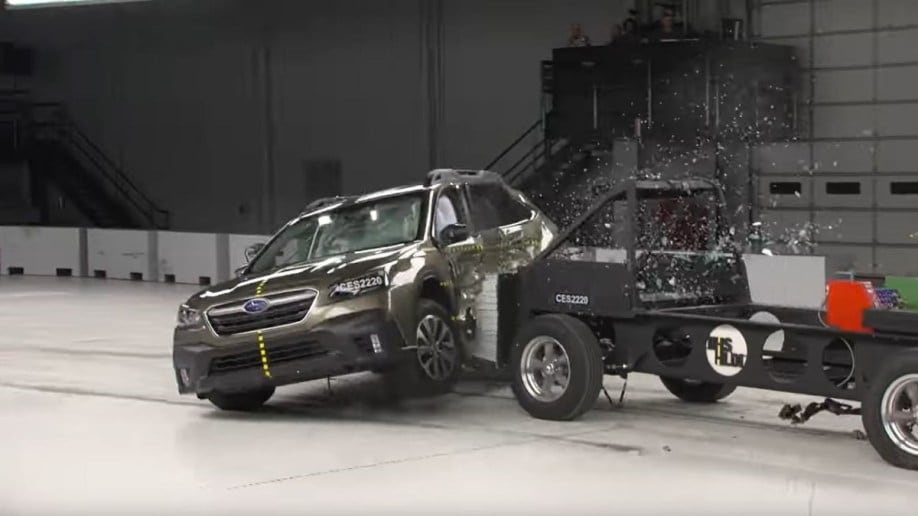
The reason? A tougher side-impact crash test and a test to see whether pedestrian detection systems work well at night.
America’s Two Crash-Testing Agencies
America is unusual in that it has not one but two agencies that perform crash tests on nearly every car for sale in the country.
One belongs to the federal government. The National Highway Traffic Safety Administration (NHTSA) conducts tests and rates cars for safety on a 5-star scale.
But the insurance industry funds a separate lab that conducts its own crash tests.
Insurance companies have a financial interest in making car crashes as rare and safe as possible. So a group of them fund their own safety agency that conducts its own battery of tests — the Insurance Institute for Highway Safety, or IIHS.
Industry insiders tend to rate IIHS tests as a more demanding standard. Before NHTSA can modify its criteria, it must accept public comments on any proposed change and subject changes to congressional scrutiny. That tends to mean fewer new tests and can mean tests watered down by industry lobbying.
The IIHS, however, can toughen its standards whenever it thinks the step is warranted. It only needs permission from insurance companies, who want the tests to be hard to pass.
New Side Impact Tests
For this year, that means a tougher side-impact test.
Side impacts cause about one-quarter of traffic deaths. The IIHS, studying side-impact crashes, concluded that its existing test model didn’t accurately represent the risks of today’s accidents. It adopted a new crash sled that better simulates the height and weight of the trucks and SUVs that outsell cars in today’s market.
It also increased the speed of crashes, from 31 to 37 mph, based on data representing the average crash in recent years.
As expected, fewer vehicles have passed the new, more stringent test.
Nighttime Pedestrian Detection Tests
The institute introduced new testing for automatic emergency braking systems intended to detect pedestrians and help cars brake to avoid hitting them. After IIHS research showed that many such systems are far less effective in low-light situations, the institute introduced a nighttime test.
New Award Criteria
The IIHS gives out two awards to vehicles that perform well in its tests.
The institute awards a rating of Good, Acceptable, Marginal, or Poor based on how well each vehicle protects simulated occupants in each crash test. It judges automated emergency braking tests on a different scale — Basic, Advanced, or Superior — based on whether the car successfully slows or stops itself to avoid hitting a simulated pedestrian.
To earn the silver medal — Top Safety Pick — a vehicle must earn a Good rating in frontal-offset testing, Good or Acceptable in side-impact testing, and Advanced or Superior in daytime emergency braking system tests. It must also have headlights the agency rates as Acceptable or Good.
To earn gold — Top Safety Pick+ — a vehicle must earn a Good score in the side-impact test. Acceptable is no longer acceptable. It must also earn a score of Advanced or Superior in nighttime emergency braking system tests and pass the same headlight standard.
The Winners: Top Safety Pick +
Small cars
Midsize cars
- Subaru Outback
- Toyota Camry built after January 2023
Large luxury cars
Small SUVs
- Honda CR-V
- Honda HR-V
- Lexus UX
- Subaru Solterra (electric) built after October 2022
Midsize SUVs
- Hyundai Palisade
- Kia Telluride
- Nissan Pathfinder
- Subaru Ascent
- Toyota Highlander
- Volkswagen ID.4 (electric)
Midsize luxury SUVs
- Acura MDX
- Acura RDX
- Infiniti QX60
- Lexus NX
- Lexus NX Plug-in Hybrid
- Lexus RX
- Tesla Model Y (electric)
- Volvo XC90
- Volvo XC90 Recharge (plug-in hybrid)
Minivans
Large pickups
The Runners Up: Top Safety Pick
Small cars
- Honda Civic hatchback except Type R performance variant
- Honda Civic sedan
- Mazda 3 hatchback
- Mazda 3 sedan
- Toyota Corolla hatchback
- Toyota Corolla sedan
Midsize cars
- Hyundai Sonata built after December 2022
- Subaru Legacy
Midsize luxury cars
Small SUVs
- Mazda CX-30
- Mazda CX-5
- Mazda CX-50
- Nissan Rogue
- Subaru Forester
- Toyota RAV4
- Toyota RAV4 Prime (plug-in hybrid)
- Toyota Venza







